Natural History Illustration: A Stag Beetle in Woodland

I had a wonderful comission recently; to do a natural history illustration of a stag beetle to accompany a poem by Chris Meredith.
Starting the job
I began by reading the poem carefully (I’ve transcribed it at the end of this article) to get the atmosphere right, and to list what species I’d be needing to illustrate. These included ones named in the poem, but also making sure there was enough of a variety of other plants and animals in there so the image would be full of life, and the colours wouldn’t be isolated within the composition.
Next step is a very swift set of thumbnail sketches, these are just different ideas on how to include all the elements into a composition that will work and lead the eye into and through the painting. Below is the one I settled on.
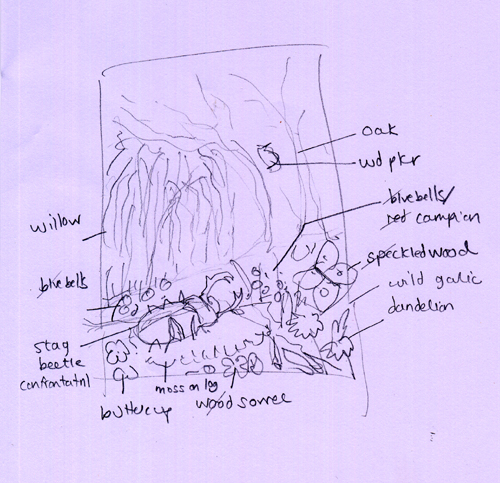
Gathering reference
Then reference for all the species needs to be collated. I have sketchbooks of botanical studies, and have assembled loads of ring binders crammed with my photos and notes, all organized alphabetically and by type of organism. I also refer to google images for a broad spectrum of views of one animal or plant, and increasingly find myself using my own earlier illustrations for reference.
Piecing together the background of a rough takes a while; this one is loosely based in Cwm Byddog, a beautiful nature reserve run by Radnorshire Wildlife Trust, near my home.
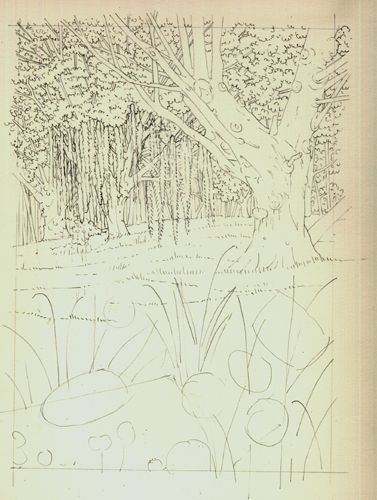
Drawing up the rough
I leave the foreground until later, but it’s important to block in where the animals and plants will be so that you can construct the scene around them.
Next, I spend time on the animals, the focus of the illustration. If these aren’t drawn correctly the entire illustration will fall apart, so it’s an exacting business and calls for consulting lots of reference and always, if possible, an actual specimen.

With both background and the animals plotted in, I can construct the flora and habitat around them, remembering to lose size and definition as the image goes towards the background; and trying to ensure the eye moves easily across the illustration.

Painting in the background
Once I’m satisfied with the rough, it’s time to get the paints out. Over the years, I’ve found that the more disciplined I am, and the paler I keep the farthest areas of the painting, the more depth I get. So I start with the most distant features in a very pale, blue-ish palette.
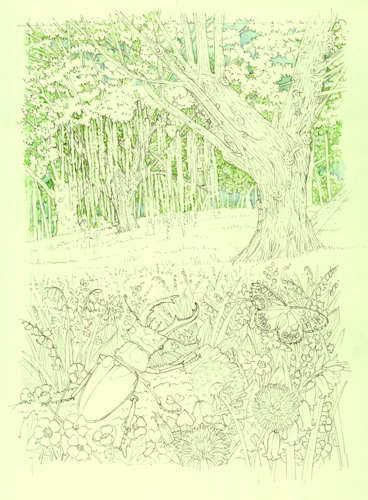
Next comes a little more detail, and as I paint further to the front of the image there is more contrast and depth of colour. I work very hard at not getting the middle distance too muddy or dark; with watercolour you can always come back and work into it later, but it’s far too easy to swallow up the light and thus flatten the illustration. I paint the background around the more detailed elements in the foreground, and it’ll be the prime point of focus (in this case the stag beetle) that gets painted last of all.
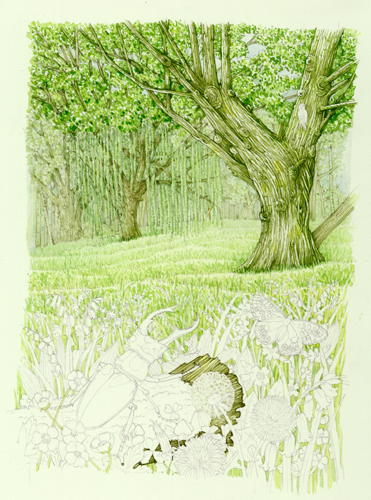
Adding Detail to the Background
I work more detail into the background, and put some very pale washes over the leaves of the trees. Then it’s time to work on the flowers, which is lovely. I use a tiny brush (winsor and newton series 7, size 0 or 00) and make sure the colours at the back are really pale. This means mixing in reverse; you mix the colour you’ll need for the flowers in the foreground, dilute it enormously, then work from the furthest background forward, adding minute drops of the colour as you progress. Sharp detail as well as intensity of colour and contrast bring things into the foreground, so I’ll keep detail to a minimum until you’re right at the front of the illustration.
I paint in the details of the flowers, and work further towards the front of the painting; we’re approaching the point where it’s all looking coherent except for the white cut-out spaces where the animals are going to be.
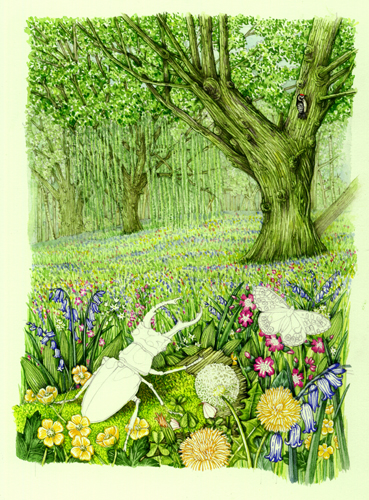
Once I’ve blocked in the flower shapes, and “drawn” them with their correct colours, I work into them with washes and then with overlying shadows. Again, it’s vital not to swamp the details by making the washes too heavy or dark; white areas in a watercolour are what keep the painting fresh.
Painting the Stag beetle and other animals
Finally, I get to work on the animals, my favourite part. I block in the darkest areas first and then work into them, up towards the lighter areas. With the butterfly it’s important to keep the venation clear as it gives the insect some real structure. I unify the details of the animals with a series of washes. Sometimes at this stage I panic and think I’ve ruined it all, but it’s normally a minor or easily salvageable mistake.

Finishing up
The last step is to take a quick tea break then come back and consider the painting as a whole. Does anything need tweaking or sharpening up? Do any elements stand out more than they should? Are the shadows clear enough, and coherent in terms of the light source? Is there enough detail in the mid ground, and enough colour in the foreground? Once these final questions have been dealt with, and adjustments have been made, it’s time to scan the final artwork (at 300 plus dpi) and send a copy to the client to see what they think. In this case, I’m elated to say, the client was really pleased. A lovely job to do, for a happy client. That’s my idea of a dream job.
I have made a short youtube video of this painting process:
Under the Shadow of the Tree by Chris Meredith
Under the shadow of the tree
We are cool in each other’s company
The breeze gently moving your hair
A piece of sunlight highlighting your eyes
Under the shadow of the tree
Our love secretly takes shape
Beneath the wind and the willows
Our shadows sleep
Under the shadow of the tree
Raindrops lightly dust the moss
I place a buttercup under your chin
You blow a dandelion to the wind
Under the shadow of the tree
A stag beetle challenges us to a fight
Our laughter downgrades the threat
As well it might
For more poems by Chris Meredith please look at his Chris Meredith website.

